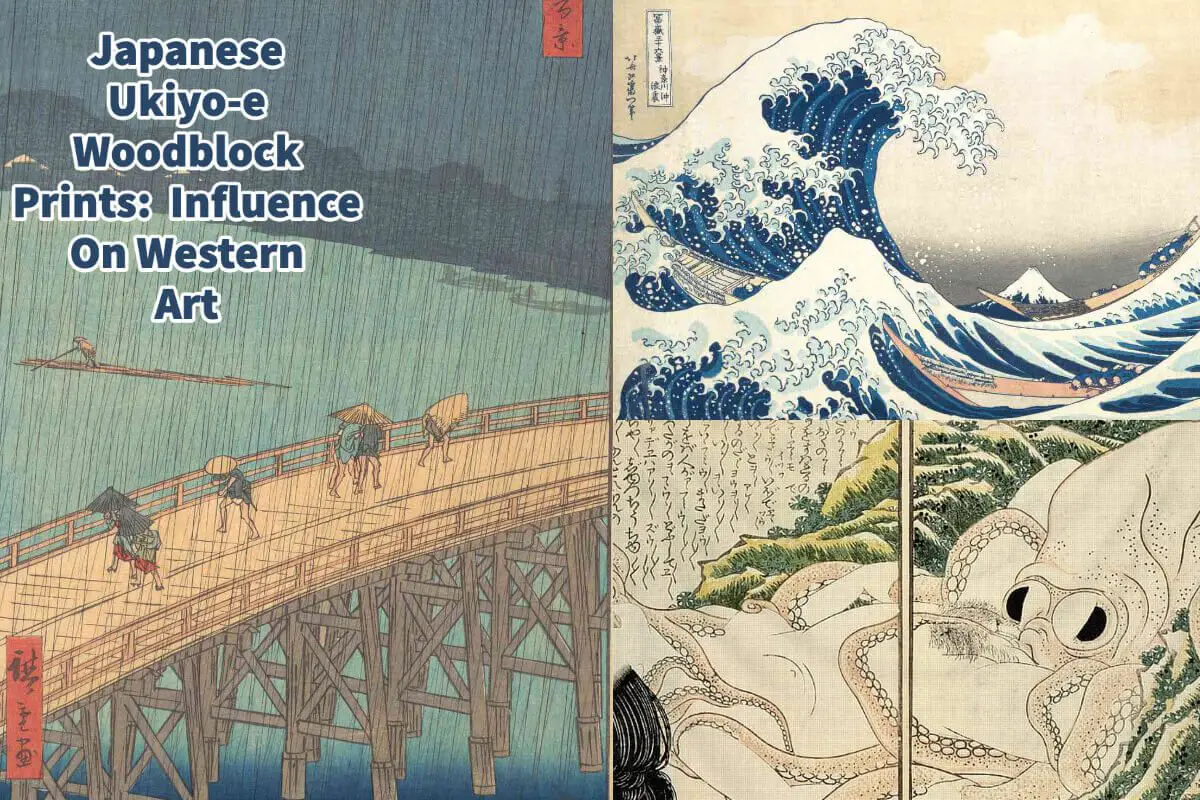Japanese Ukiyo-e woodblock prints, a distinctive art form that emerged in the 17th century, continue to captivate art enthusiasts and inspire artists worldwide. It is one of my favorite art movements, as it influenced many great Western artists.
Ukiyo-e, meaning “pictures of the floating world,” depicts scenes from everyday life, landscapes, historical tales, and renowned kabuki actors. We will explore the origins and significance of Ukiyo-e woodblock prints and delve into their profound impact on Western artists, shaping their artistic styles and influencing the course of Western art history.
Table of Contents
- Understanding Japanese Ukiyo-e Woodblock Prints – 3 Points
- Significance Of Ukiyo-e Woodblock Prints In Art
- 8 Influential Japanese Woodblock Prints
- “The Great Wave off Kanagawa” by Katsushika Hokusai (1830-1833)
- “The Dream of the Fisherman’s Wife” by Hokusai (c. 1814)
- “The Plum Garden in Kameido” by Hiroshige (1857)
- “Woman Relaxing after Her Bath” by Kitagawa Utamaro c. (1615–1868)
- “Beauty Looking Back” by Hishikawa Moronobu (c. 1680s)
- “The Sudden Shower over Shin-Ōhashi Bridge and Atake” by Hiroshige (1857)
- “Actors Otani Oniji III as Edobei” by Toshusai Sharaku (1794)
- “The Lovers” (Koi-zuru) by Suzuki Harunobu (c. 1765)
- Western Artists Influenced By Ukiyo-e Prints
- Impressionism And Japonisme
- Frequently Asked Questions
- Related Questions
Understanding Japanese Ukiyo-e Woodblock Prints – 3 Points
Japanese woodblock prints are essential for every artist to understand as not only did they play an important role in Western art, and they are just masterful works of art. We will explore three points to help you understand Japanese woodblock prints and Ukiyo-e.
Definition And Characteristics Of Japanese Ukoyo-e Woodblock Prints
Ukiyo-e woodblock prints originated in the bustling urban centers of Edo (modern-day Tokyo) and Kyoto during the Edo period (1603-1868) in Japan. This art form involved a collaborative process, with artists, block cutters, printers, and publishers working together to produce vibrant and detailed prints.
Ukiyo-e prints typically featured bold outlines, flat areas of color, intricate patterns, and a strong emphasis on visual storytelling.
Subjects And Themes Of Japanese Ukiyo-e Woodblock Prints
The prints captured various subjects, including landscapes, famous sights, geishas, sumo wrestlers, historical events, and kabuki theater performances. Ukiyo-e prints allowed the ordinary people of Japan to experience a sense of escapism, offering glimpses into a world of beauty, entertainment, and fantasy.
Techniques And Printing Process Of Japanese Ukiyo-e Woodblock Prints
The Ukiyo-e printmaking process involved several steps, including the initial design, the carving of the wooden blocks, and the final printing. Skilled artists drew the original design on paper, which was then transferred to wooden blocks.
Carvers meticulously cut the blocks, with each color requiring a separate block. Finally, the printers inked the blocks and pressed them onto paper, resulting in multiple vibrant layers of color and intricate details.
Significance Of Ukiyo-e Woodblock Prints In Art
There are many reasons why the Japanese Ukiyo-e woodblock print continues to be significant work of art. Here are three primary reasons.
Democratization Of Art
One of the primary reasons Ukiyo-e prints became so crucial to art was their role in the democratization of visual culture. Before the emergence of Ukiyo-e, art was primarily patronized by the aristocracy and the ruling class.
However, Ukiyo-e prints were affordable and accessible to the growing merchant class, allowing a broader audience to appreciate and collect art.
Influence On Aesthetics And Composition
The visual language of Ukiyo-e prints deeply impacted the aesthetics and composition of Western art. The bold use of color, flattened perspective, and asymmetrical compositions were a departure from the conventions of Western art at the time.
Western artists began to incorporate these elements into their works, challenging established norms and expanding the boundaries of artistic expression.
Exploration Of Everyday Life
Ukiyo-e prints celebrated life’s mundane and everyday aspects, contrasting Western art’s predominantly religious and mythological themes. This emphasis on depicting ordinary people engaged in everyday activities greatly influenced Western artists, who started to explore similar subjects and themes, infusing their work with a sense of realism and relatability
8 Influential Japanese Woodblock Prints
We have picked out these eight woodblock prints and their respective artists as we feel they represent pivotal moments and themes within the history of Ukiyo-e. They highlight the technical mastery, innovation, and cultural exploration inherent in Ukiyo-e prints and their profound impact on the development of art both in Japan and the Western world.
“The Great Wave off Kanagawa” by Katsushika Hokusai (1830-1833)
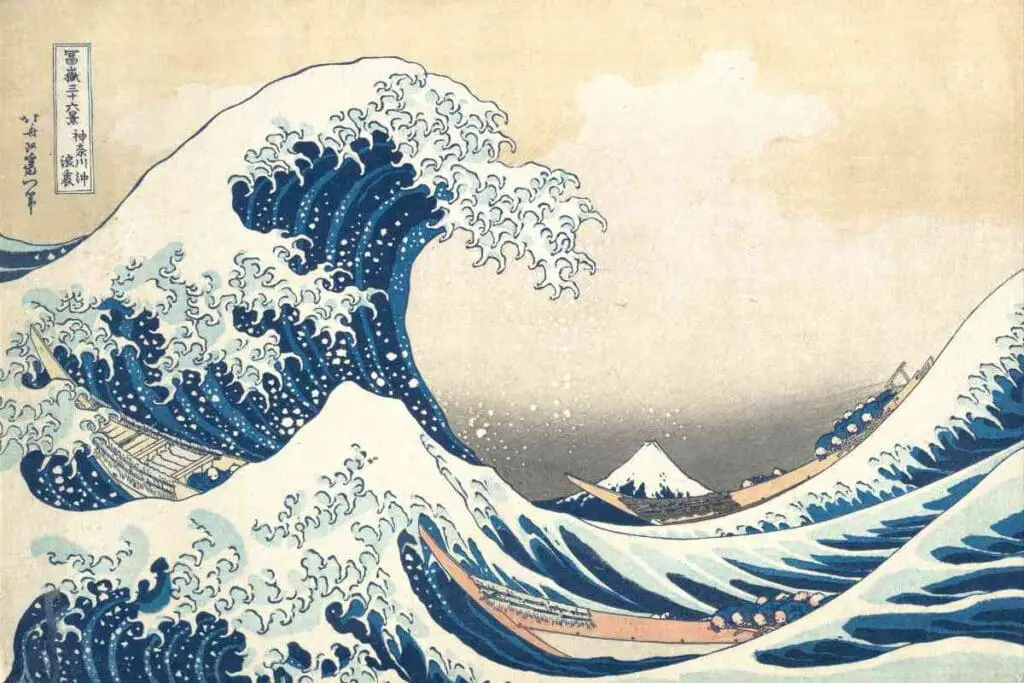
This iconic print from Hokusai’s series “Thirty-Six Views of Mount Fuji” is arguably one of the most recognizable artworks in the world. It showcases a towering wave about to crash upon boats beneath Mount Fuji, exemplifying Hokusai’s mastery of composition, dynamic movement, and use of color.
“The Dream of the Fisherman’s Wife” by Hokusai (c. 1814)
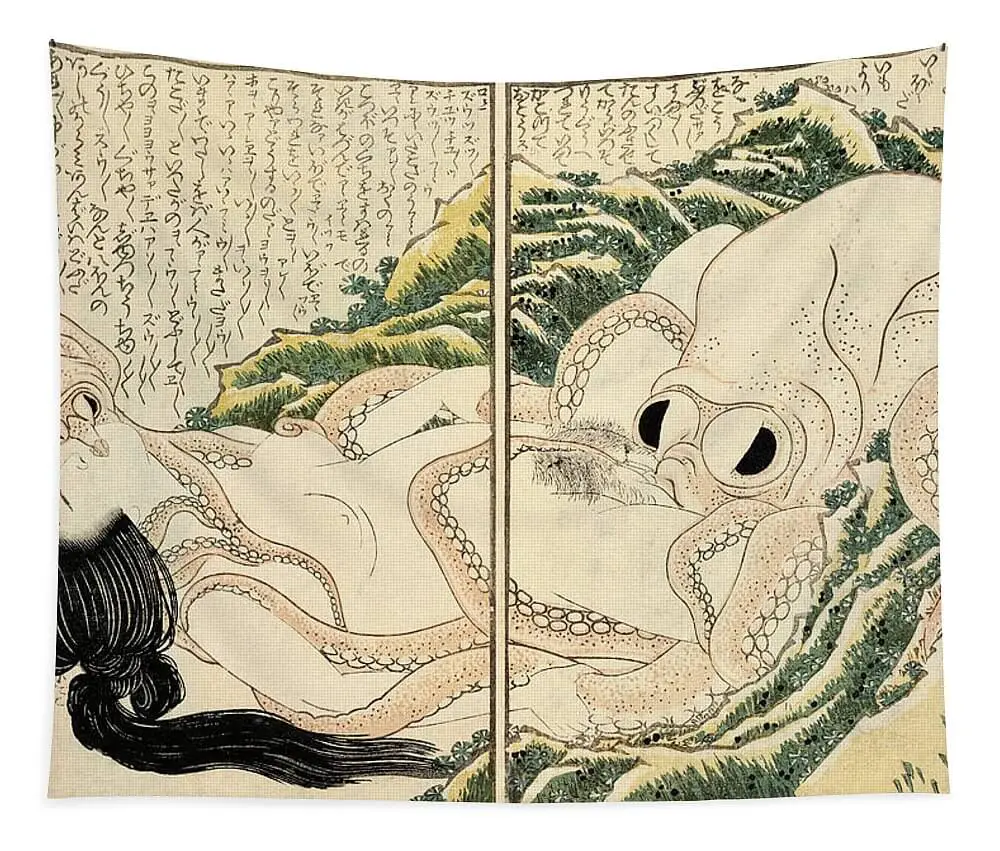
This highly controversial and erotic print is part of Hokusai’s series “Kinoe no Komatsu” and depicts a female diver engaged in a sexual encounter with a pair of octopuses. It represents the exploration of sexuality and the supernatural in Ukiyo-e prints, pushing the boundaries of societal norms.
“The Plum Garden in Kameido” by Hiroshige (1857)
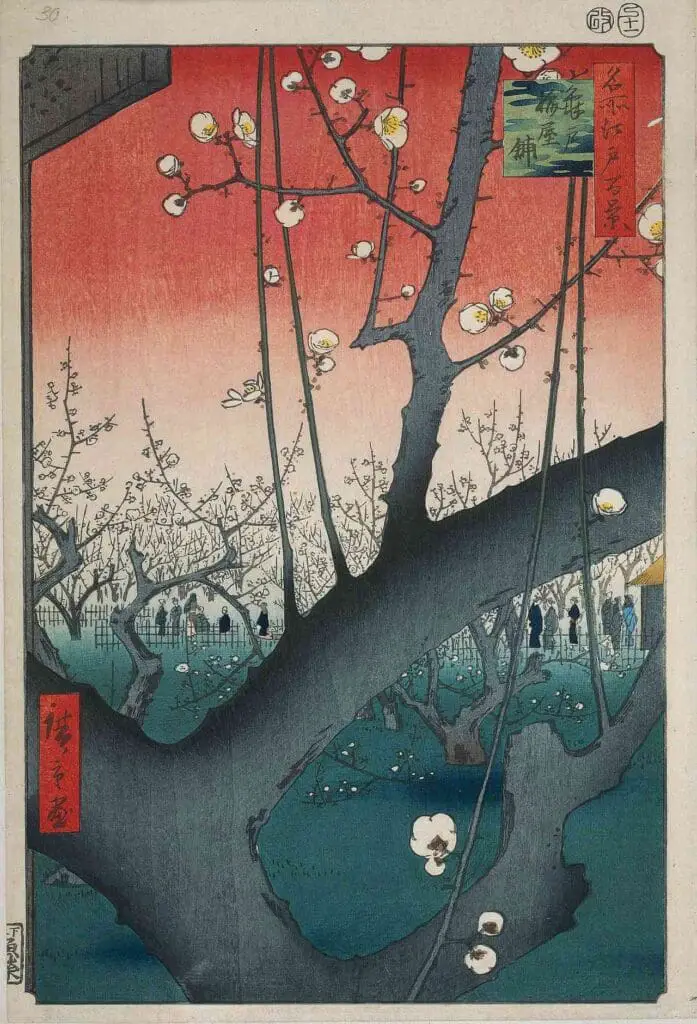
From Hiroshige’s series “One Hundred Famous Views of Edo,” this print captures the serene beauty of a plum garden in full bloom. It demonstrates Hiroshige’s ability to depict landscapes with intricate details, vibrant colors, and a sense of tranquility, influencing Western landscape painters.
“Woman Relaxing after Her Bath” by Kitagawa Utamaro c. (1615–1868)
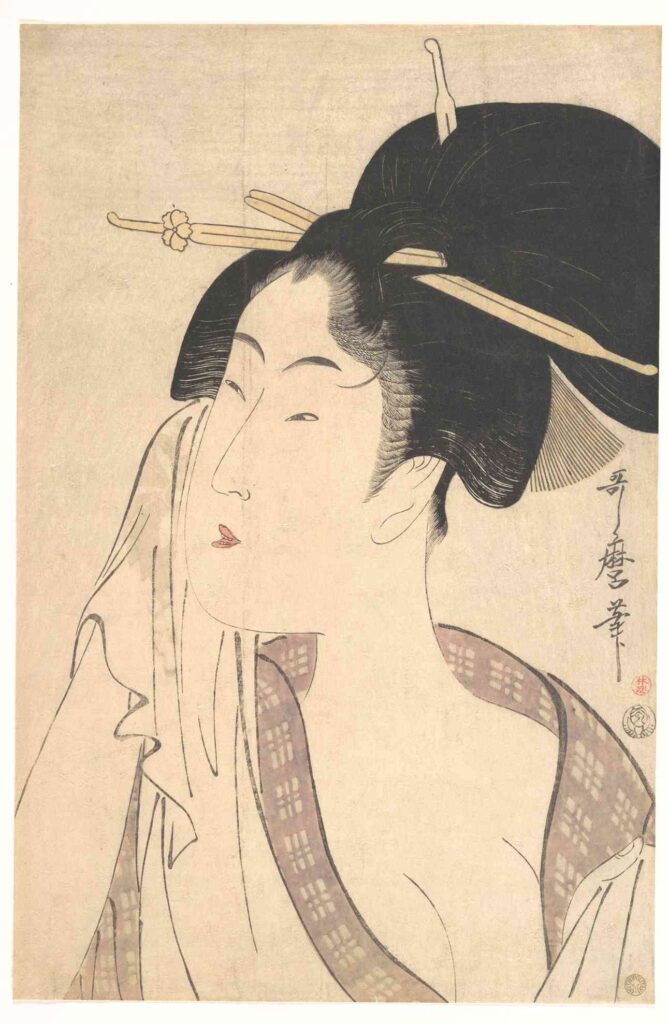
Utamaro’s print portrays three women in a public bathhouse engaged in personal grooming. It exemplifies his mastery of depicting women in intimate settings, focusing on their beauty, clothing, and expressions. Utamaro’s prints greatly influenced Western artists’ portrayal of women and the concept of the “femme fatale.”
“Beauty Looking Back” by Hishikawa Moronobu (c. 1680s)
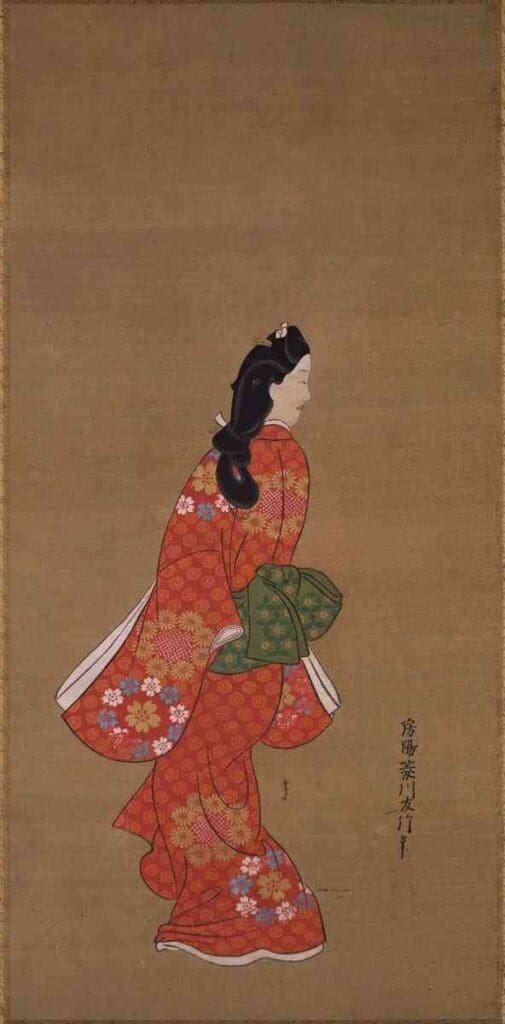
As one of the earliest known Ukiyo-e prints, Moronobu’s work marks the beginning of this art form. It depicts a woman looking over her shoulder, showcasing the elegant lines and delicate rendering of figures that became characteristic of Ukiyo-e prints.
“The Sudden Shower over Shin-Ōhashi Bridge and Atake” by Hiroshige (1857)
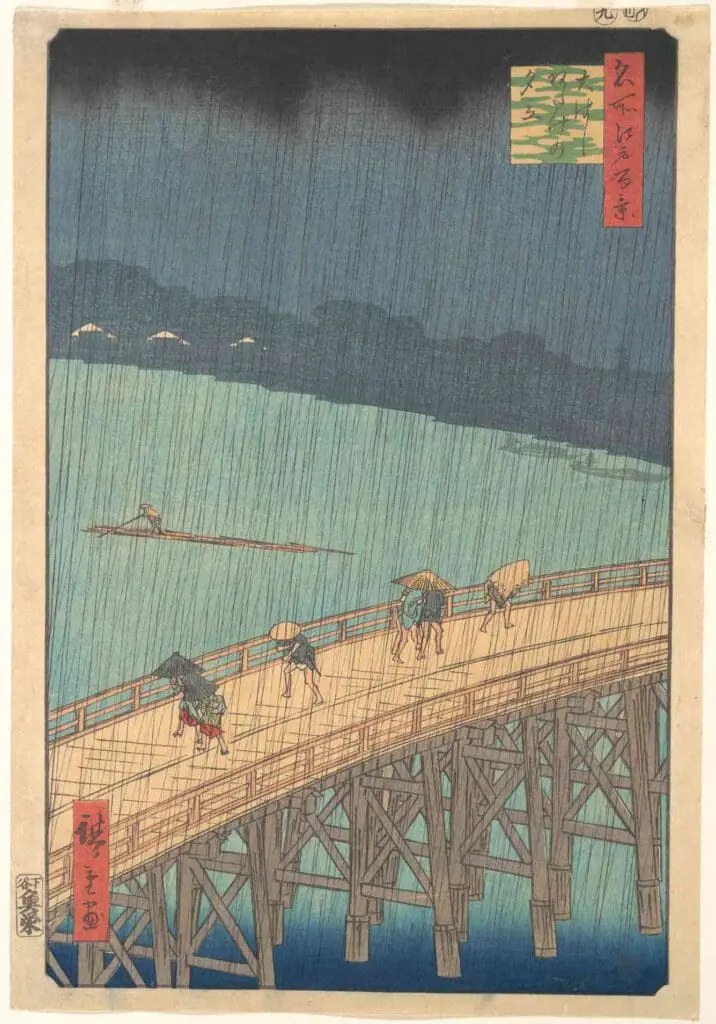
Part of Hiroshige’s series “One Hundred Famous Views of Edo,” this print captures a sudden rain shower drenching pedestrians on a bridge. It exemplifies Hiroshige’s skill in depicting weather conditions and his innovative use of composition, capturing a fleeting moment and evoking a sense of atmosphere.
“Actors Otani Oniji III as Edobei” by Toshusai Sharaku (1794)

Sharaku’s prints, known for their striking portraits of actors, significantly impacted the representation of kabuki actors in Ukiyo-e prints. “Actors Otani Oniji III as Edobei” is a notable example, showcasing Sharaku’s ability to capture the intensity and individuality of the actors’ expressions, departing from the idealized portrayals of earlier Ukiyo-e prints.
“The Lovers” (Koi-zuru) by Suzuki Harunobu (c. 1765)

Harunobu’s print depicts a couple engaged in an intimate embrace, representing romantic love. This work is significant as it marks the emergence of full-color printing in Ukiyo-e, showcasing Harunobu’s delicate and poetic style that profoundly influenced subsequent Ukiyo-e artists.
Each Japanese woodblock print showcases unique artistic techniques, subject matters, or influences that have contributed to the enduring legacy of Ukiyo-e as a vital and influential art form.
Listen To Our Podcast About Unveiling The Influence Of Japanese Ukiyo-e Woodblock Prints On Western Art below or by clicking here.

Western Artists Influenced By Ukiyo-e Prints
When Japan opened to trade in 1853, many traders started to bring back Japanese woodblock prints to some of the art training houses in Europe. These woodblock prints influenced many Western artists.
Here are some of the significant Western artists that were influenced by woodblock prints:
Vincent van Gogh
Vincent van Gogh, renowned for his expressive and vibrant style, was deeply influenced by Japanese Ukiyo-e prints. He collected and studied these prints, incorporating their aesthetic elements into his work.
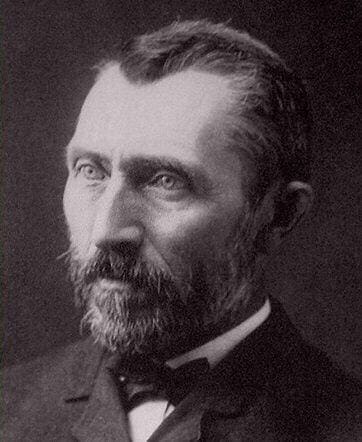
Van Gogh’s use of bold colors, flattened perspective, and swirling brushstrokes in paintings such as “The Courtesan” and “The Bridge in the Rain” demonstrates the impact of Ukiyo-e prints on his artistic style.

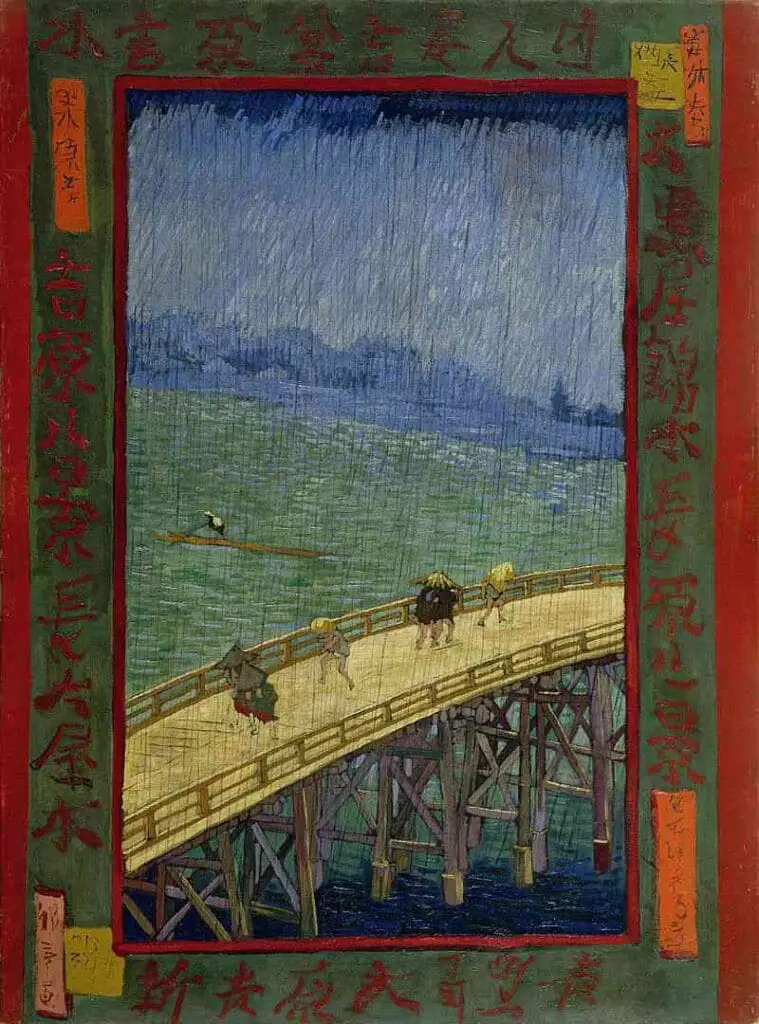
Van Gogh’s fascination with Japanese culture extended beyond aesthetics, as he admired the sense of harmony and simplicity in Japanese art, which resonated with his artistic philosophy.
Mary Cassatt
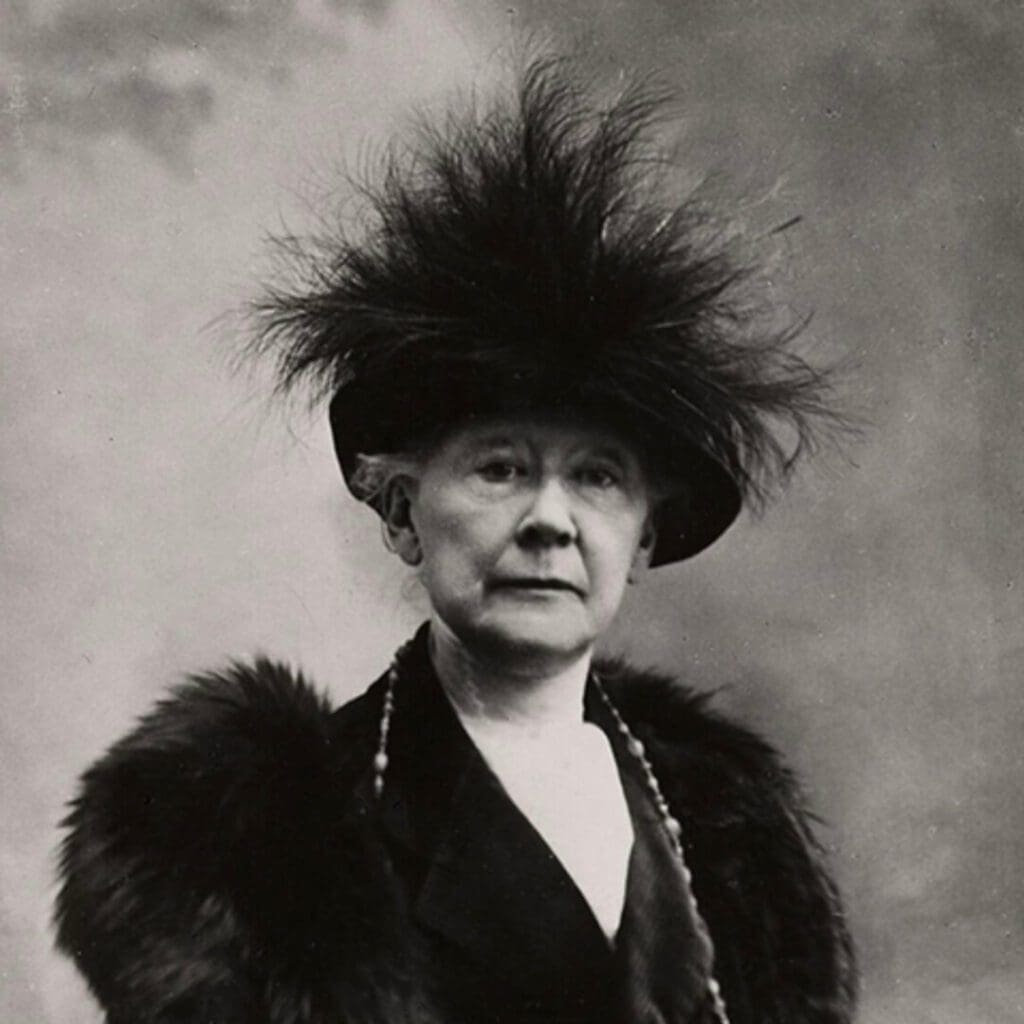
Mary Cassatt, an American Impressionist painter, was introduced to Ukiyo-e prints during a trip to Paris in the late 19th century. She was captivated by the delicate lines, flattened perspectives, and depictions of intimate domestic scenes found in Ukiyo-e prints.
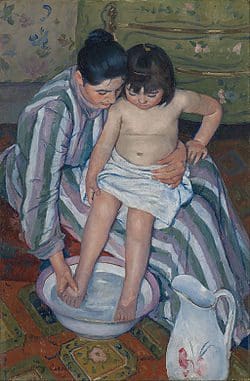

Cassatt incorporated these elements into her work, particularly in her portrayals of women and children. Her paintings, such as “The Child’s Bath” and “Maternal Caress,” showcase the influence of Ukiyo-e in their composition and subject matter.
Edgar Degas
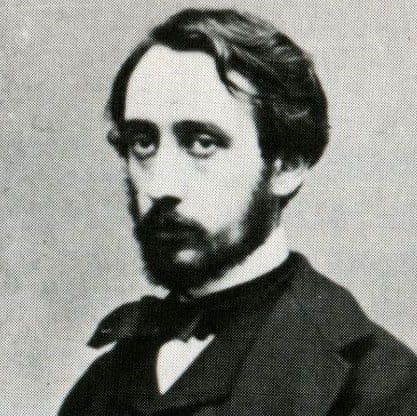
Edgar Degas, another prominent figure of the Impressionist movement, was strongly influenced by Ukiyo-e prints, particularly in his exploration of dynamic compositions and unconventional viewpoints.
Degas incorporated elements of Japanese woodblock prints into his depictions of ballet dancers, capturing the grace and movement of the human form. The influence of Ukiyo-e can be seen in works like “The Dance Class” and “The Star.”
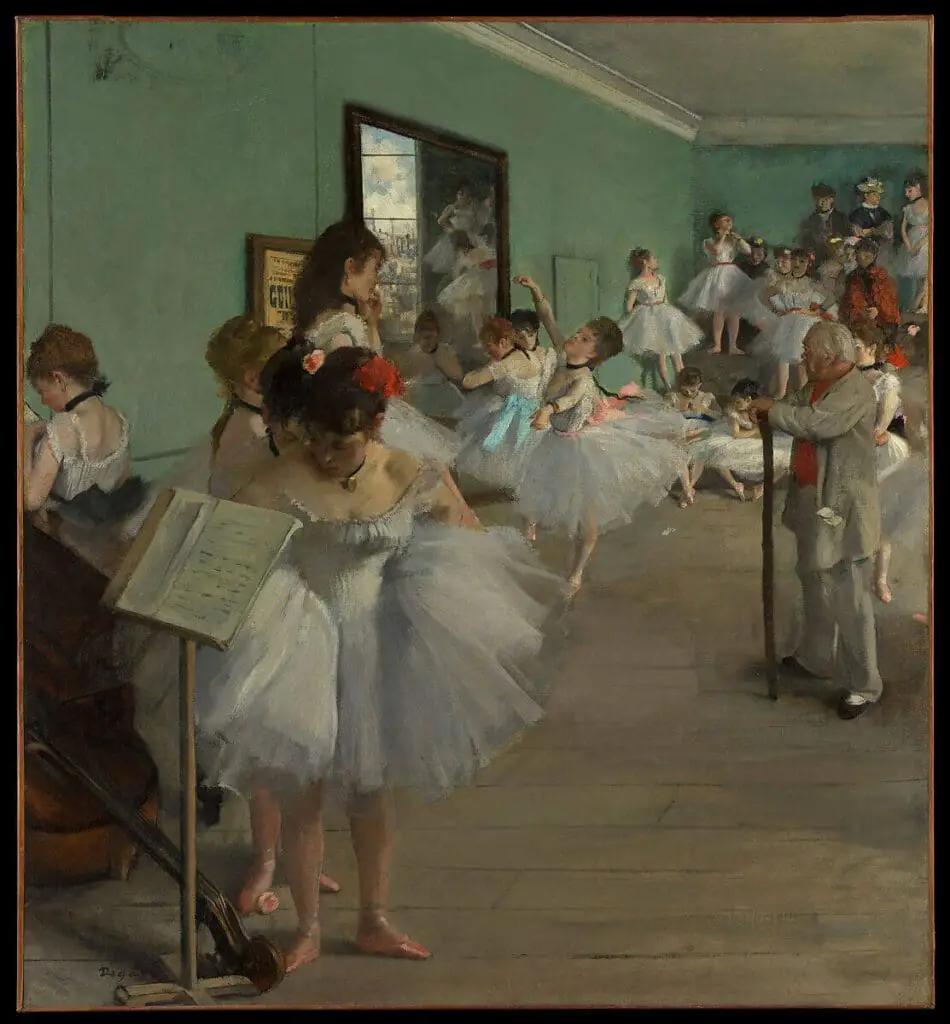

Henri Toulouse-Lautrec
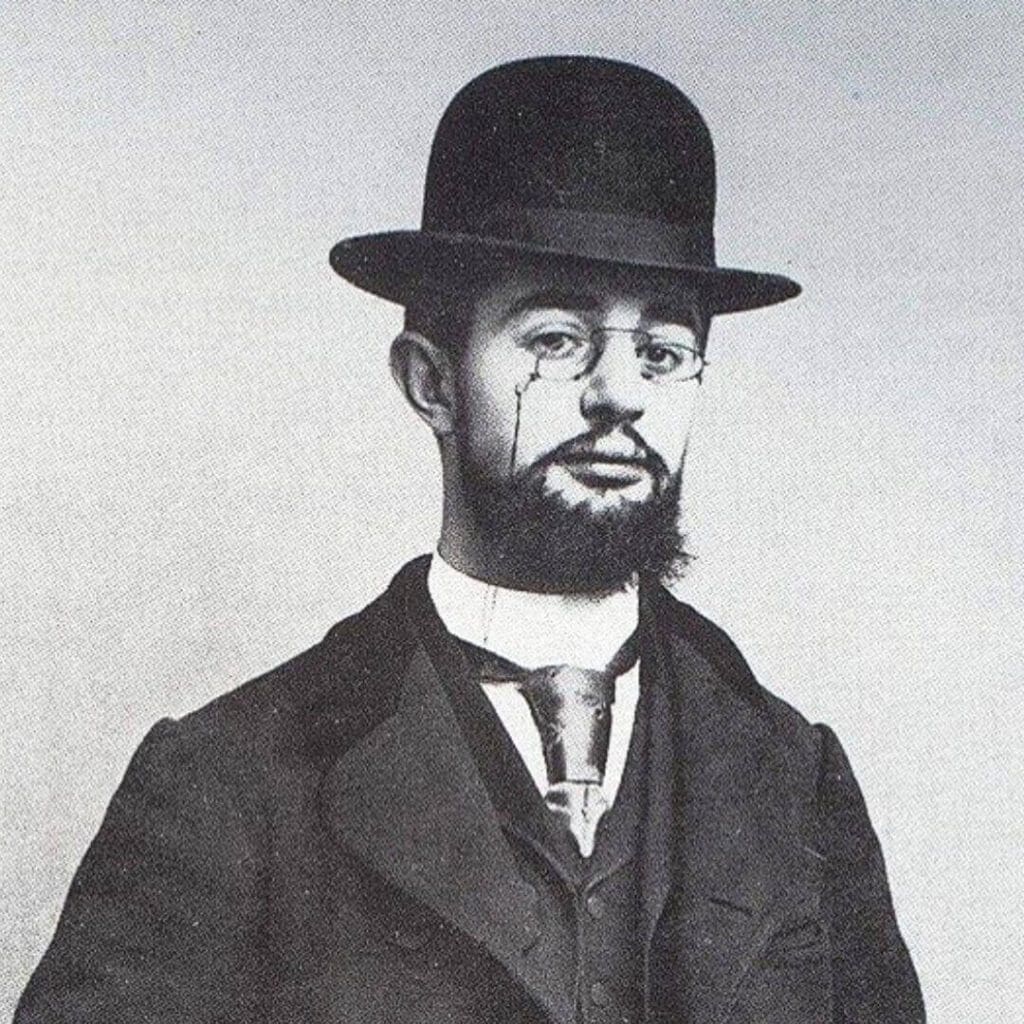
Henri Toulouse-Lautrec, a French painter and printmaker, was drawn to the vibrant and lively world of the Japanese Ukiyo-e prints. He admired their bold use of color and their portrayal of the entertainment districts of Japan.


Toulouse-Lautrec’s iconic posters depicting performers and cabaret scenes, such as “Moulin Rouge: La Goulue” and “Divan Japonais,” display an evident influence of Ukiyo-e prints in their bold compositions and expressive use of color.
Impressionism And Japonisme
The influence of Ukiyo-e prints extended beyond individual artists and played a significant role in developing the Impressionist movement. The interest in Japanese art, Japonisme, swept through the European art scene during the late 19th century.
The bold and unconventional techniques found in Ukiyo-e prints aligned with the goals of the Impressionists, who sought to capture the fleeting effects of light and atmosphere. Incorporating Ukiyo-e aesthetics and composition in Impressionist works helped redefine the Western art canon and paved the way for modern art movements.
Japanese Ukiyo-e woodblock prints continue to hold immense significance in art, captivating audiences with their unique aesthetics and visual storytelling. Their profound influence on Western art, particularly on artists such as Vincent van Gogh, Mary Cassatt, Edgar Degas, and Henri Toulouse-Lautrec.
By embracing the techniques and subject matter of Ukiyo-e, these artists expanded the boundaries of Western art, introduced new perspectives, and paved the way for the modern art movements that followed. The enduring impact of Ukiyo-e prints on Western art stands as a testament to their artistic and cultural significance, forever connecting the art worlds of East and West.
Anita Louise Art is dedicated to art education, great artists, and inspiring others to find and create their art. We love art that uplifts and inspires. #ArtToMakeYouSmile! #ArtToMakeYouHappy!
If you are interested to see any of my art, you can find out more by clicking here. If you are interested in what inspires me and my paintings, you can discover more by clicking here.
We have a free newsletter and would love you to be part of our community; you can subscribe to the newsletter by clicking here. If you have any questions, I would be happy to talk to you. You can reach me, Anita, by clicking here.
Subscribe to our Anita Louise Art YouTube Channel filled with great videos and information by clicking here.
Join us for our podcast “5 Minutes With Art.” Spend just 5 minutes a week with us to discover and learn about great art and artists. You can find out more about our podcast by clicking here.
Frequently Asked Questions
What is Ukiyo-e, and when did it originate?
Ukiyo-e, translated as “pictures of the floating world,” is a genre of Japanese woodblock prints that emerged in the 17th century during the Edo period. It depicted scenes from the urban culture, landscapes, kabuki theater, and the world of pleasure districts.
Who were the prominent artists of Ukiyo-e?
Ukiyo-e had several renowned artists, including Katsushika Hokusai, Kitagawa Utamaro, Utagawa Hiroshige, and Suzuki Harunobu. These artists played a crucial role in shaping the aesthetics and themes of Ukiyo-e.
How did Ukiyo-e influence Western artists?
Ukiyo-e had a profound impact on Western artists during the 19th century, notably the Impressionists and Post-Impressionists. Artists such as Vincent van Gogh, Edgar Degas, and Mary Cassatt were inspired by the bold compositions, vibrant colors, and unique perspectives found in Ukiyo-e prints.
What aspects of Ukiyo-e captivated Western artists?
Western artists were particularly drawn to Ukiyo-e’s flat compositions, emphasis on line and form, and unconventional viewpoints. The use of negative space and the portrayal of fleeting moments in everyday life resonated with Western artists seeking to break away from traditional academic styles.
How did Ukiyo-e influence the development of Japonism in Western art?
Japonism refers to the fascination and influence of Japanese art on Western art. Ukiyo-e prints played a crucial role in the development of Japonism, as Western artists incorporated Japanese themes, techniques, and aesthetics into their own works.
Did Ukiyo-e have a significant impact on the decorative arts in the West?
Yes, Ukiyo-e prints influenced not only fine art but also the decorative arts. The popularity of Japanese woodblock prints inspired Western designers, leading to the incorporation of Japanese motifs in textiles, ceramics, and other decorative items.
How did the opening of Japan to the West contribute to the popularity of Ukiyo-e in Europe?
The opening of Japan to the West in the mid-19th century allowed a flood of Japanese artworks, including Ukiyo-e prints, to enter Europe. This influx of prints had a profound impact on European artists and collectors, contributing to the widespread popularity of Ukiyo-e in the West.
Were there specific themes in Ukiyo-e that resonated with Western artists?
Themes such as nature, daily life, and theatrical performances depicted in Ukiyo-e resonated strongly with Western artists seeking to move away from academic conventions. The simplicity and directness of Ukiyo-e compositions appealed to artists looking for new ways to express their creativity.
How did Ukiyo-e influence the development of modern graphic design in the West?
The graphic and stylized nature of Ukiyo-e prints influenced the development of modern graphic design in the West. Its impact can be seen in the use of bold lines, flat colors, and innovative compositions in graphic design during the late 19th and early 20th centuries.
How does the legacy of Ukiyo-e continue in contemporary Western art?
The influence of Ukiyo-e can still be observed in contemporary Western art, with artists drawing inspiration from its techniques and themes. The enduring legacy of Ukiyo-e is evident in the continued appreciation for its aesthetic qualities and its role in shaping the trajectory of Western art history.
Related Questions
Characteristics of Japanese Ukiyo-e Woodblock Prints
Japanese woodblock prints were produced to have a mass appeal to the Japanese audience. There are a lot of characteristics in the Japanese woodblock print, such as the asymmetry of design, how the artist experiments with composition, the artist’s use of flats spaces, and the use of colors.
By clicking here, you can learn more by reading Characteristics of Japanese Ukiyo-e Woodblock Printsach Other?.
What Are Some Japanese Woodblock Print Characteristics?
There are many characteristics of a Japanese woodblock print, from the woodblock print title, artist name, and publisher’s seal; other features also include the color and subject matter. Japanese woodblock prints also have different artistic art movements.
By clicking here, you can learn more by reading What Are Some Japanese Woodblock Print Characteristics?.
What Is A Japanese Woodblock Print?
A Japanese woodblock print is, as the name implies, a print that is made by using carved woodblock and applying ink on the woodblocks to print a design on paper. The Japanese woodblock artists used woodblocks to print artistic prints and even books. Artists have used the woodblock print technique in Japan for hundreds of years.
You can learn more by reading What Is A Japanese Woodblock Print? by clicking here.

